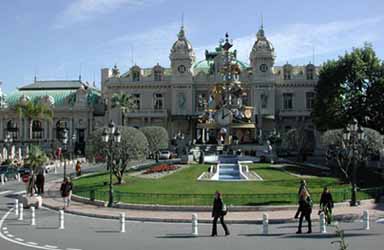|
|
Attractions
|
The Palace of the Prince |
|
For
several centuries, the citadel of Monaco was coveted by the
enemies of the Grimaldi, resulting in many conflicts with the
Genoese, the French and the Spanish. For this reason, for nearly
400 years, the Rock maintained its character as a fortress and was
principally concerned with developing its defences. Towards the
middle of the XVIIth century, Prince Honoré II (1597-1662)
undertook the earliest steps to transform it into a palace. The
military structures were retained, but the interior was totally
altered so as to house the superb collections of paintings by
master artists, tapestries and precious furniture. Towards 1690,
Prince Louis I (1642-1700) had constructed the great gate which
still exists today. This gate opens on to the Court of Honour,
admirable in its proportions, with its double stairway in Carrara
marble leading to the Gallery of Hercules and which, despite the
modifications carried out, may be considered as the old central
part of the fortress built at the beginning of the XIIIth century.
The Treaty of Paris of 1815 restored full and complete sovereignty
to Monaco and Honoré IV (1758-1819) and Honoré V (1778-1841)
undertook the restoration of the Palace robbed of its collections
and damaged to a considerable extent during the French Revolution.
Florestan I (1785-1856) pursued the work of restoration with
success. Charles III (1818-1889) had the St Mary's Tower and the
buildings surrounding it reconstructed in the style of Florentine
palaces. He gave the Chapel of St Jean the Baptist, built in 1656,
a new altar. Albert I (1848-1922) had the Clock Tower constructed
using white stone from la Turbie. Louis II (1870-1949) directed
his activities to large-scale maintenance work. Since his
accession in 1949, H.S.H. Prince Rainier III has adopted as his
goal the embellishment and modernization of the Palace. The old
frescoes were restored. The Court of Honour was paved with three
million white and coloured stones forming immense geometrical
figures. The southern wing, destroyed during the Revolution, was
rebuilt and now houses the private apartments of the Sovereign's
family as well as the Museum of Souvenirs of Napoleon and the
Archives of the Prince's Palace.
The great apartments are open to the public from June to October,
while the Napoleonic Museum and the Archive collection may be
visited throughout the year.
Every day, at noon, the ceremony of the Changing of the Guard is
performed by the section of the carabiniers responsible for
guarding the Prince's Palace. It takes place on the Palace Square,
using a ceremonial involving a great deal of marching and
counter-marching which evokes the admiration of the large number
of tourists. |
|
The Cathedral of Monaco |
|
The
first stone of the Cathedral was laid on 6th January 1875 during
the reign of Charles III. Construction was completed in 1884.
Three years later, the Principality, which until then was
religiously affiliated with the See of Nice, was raised to a
Diocese attached directly to Rome. Under the terms of a Convention
signed on July 31, 1981 between the Holy See and the Principality,
its incumbent now has the rank of Archbishop. The Cathedral of
Monaco is built entirely with white stone from la Turbie like the
Clock Tower of the Prince's Palace, and is dedicated to the
Immaculate Conception. The Cathedral was designed in the style of
the XII century. It has three naves and an ambulatory where the
sepultures of past Princes are found. The pillars are of granite
and porphyry of various colours, while the main altar is of
Carrara marble. One may admire an altar-piece and a pietà of the
primitive master painter Louis Brea, two paintings from the XVIth
century, a processional canopy bearing the arms of Prince Antoine
I (1661-1731), an altar of gilded wood from the Spanish
Renaissance, and a mosaic in the cupola. |
 |
|
Government House |
|
Facing the Albert I Grammar School, the Government House was
inaugurated in June 1894 by Prince Albert I. It is the residence
of the Minister of State and the headquarters of the Monégasque
high administration. Located on the site of the building called
the Lonely House, Prince Antoine I had it built in the first years
of the XVIIIth century in order to allow his wife, Princess Marie
de Lorraine, to escape from the frivolities of the Court. |
|
The Casino |
|
World renowned, its fabulous history was linked from the very
beginning with that of the Belle Epoque. Its foundations were laid
in 1861, during the reign of Charles III, on the isolated plateau
of the Spélugues which was to become, five years later, the new
town of Monte-Carlo. Today it is the main building, the work of
the architect Charles Garnier, surmounted by two pinnacles over a
glass roof, with a neo-classical facade, opening on the
Monte-Carlo side on to a vast staircase leading to the entrance
hall which lies in front of the Opera Hall. <br><br>The main
building is connected on its left (when seen from the front) to a
series of other buildings which house the gaming rooms which are
open every day (except May 1) from midday onwards. <br><br> (See
also the work by Philippe Saint-Germain and Francis Rosset "La
Grande Dame de Monte-Carlo"). |
|
|